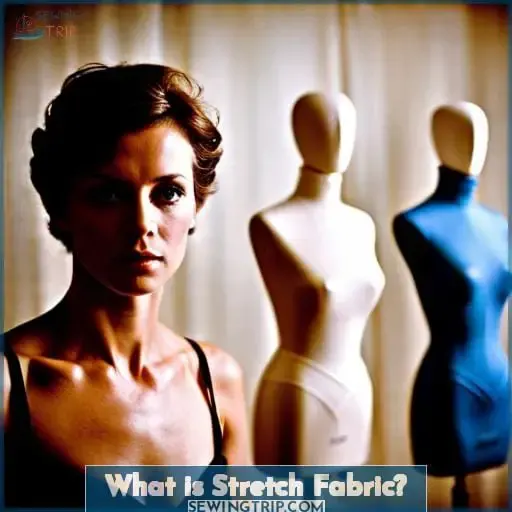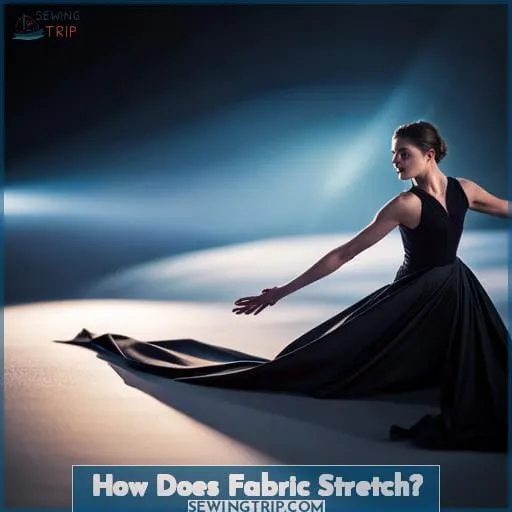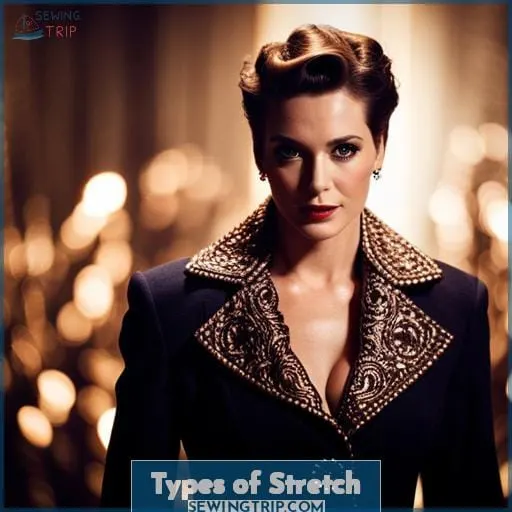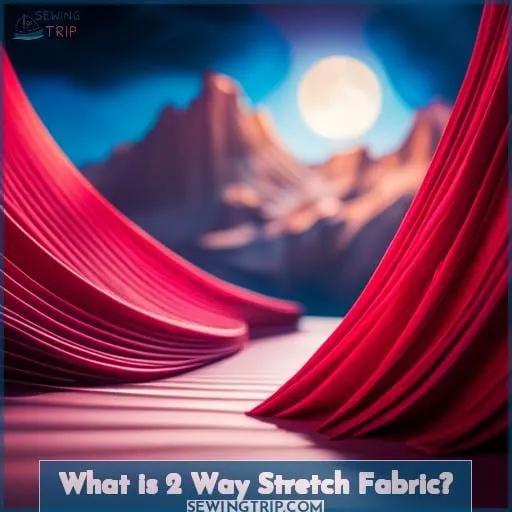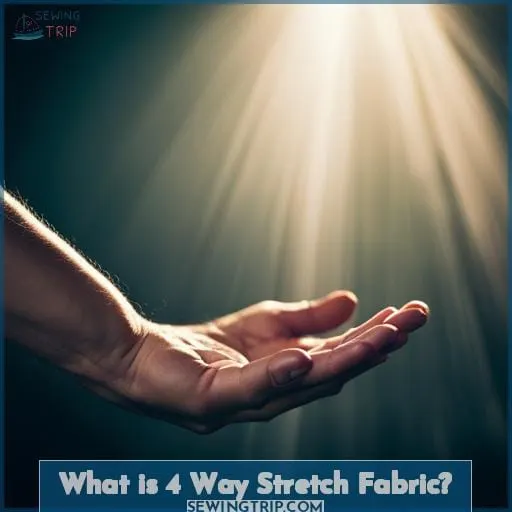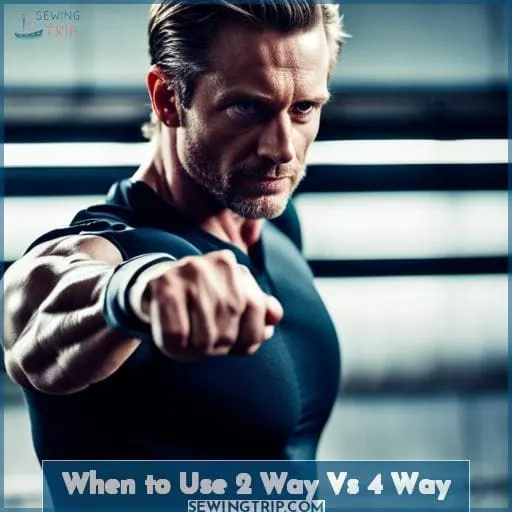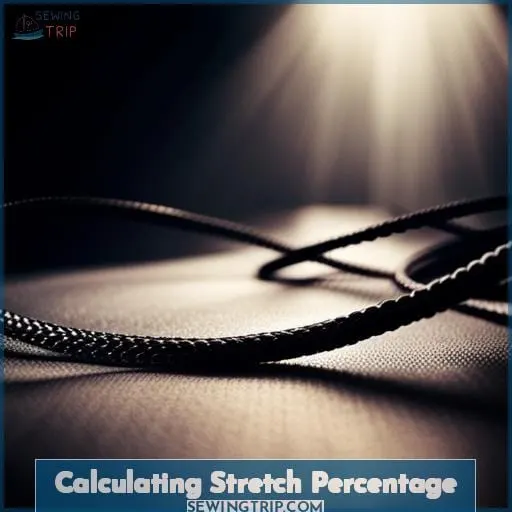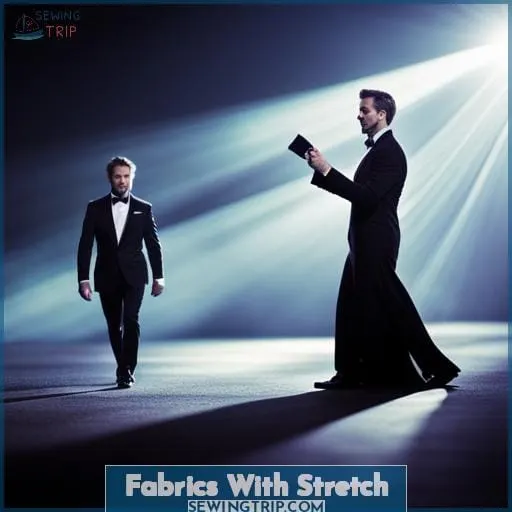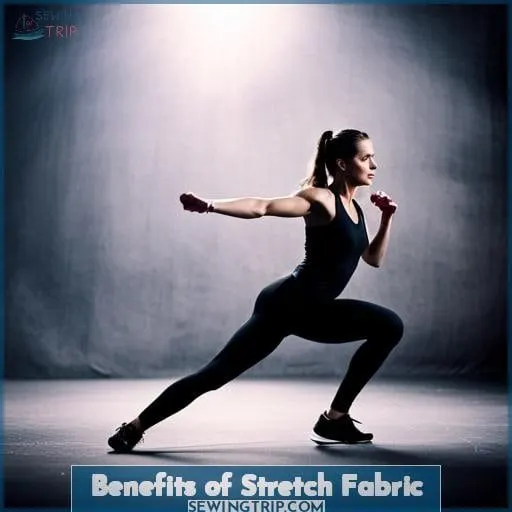This site is supported by our readers. We may earn a commission, at no cost to you, if you purchase through links.
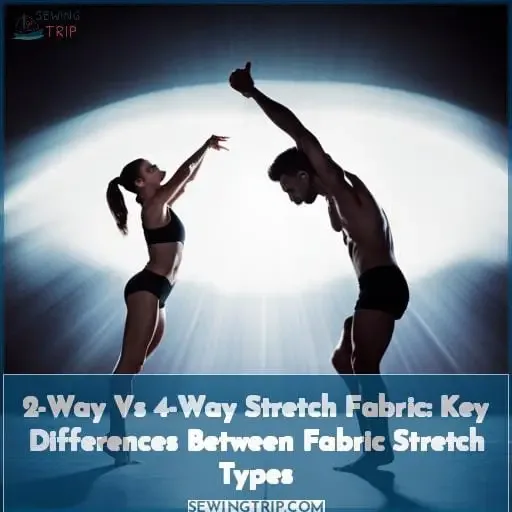
Between 2-way and 4-way varieties, the difference lies in the stretch capability. 2-way fabric stretches horizontally, while 4-way also extends vertically. As you explore new styles through sewing, consider how each stretch type creates freedom of movement.
Thoughtfully plan patterns and prints. The right fabrics help you feel at home in the world and within yourself.
Table Of Contents
Key Takeaways
- Two-way stretch fabric stretches horizontally, while four-way stretch fabric stretches both horizontally and vertically.
- Two-way stretch is suitable for casual wear that requires flexibility in one direction, whereas four-way stretch works well for activewear that needs multidirectional stretch.
- The stretch in knit fabrics comes from the loops, while added stretch in woven fabrics derives from elastic fibers like spandex or elastane.
- When selecting between two-way and four-way stretch fabrics for a garment, consider the amount of stretch and recovery required.
What is Stretch Fabric?
You’ve got options when it comes to stretch fabrics – it’s all about understanding what kind of stretch you need. Knits and wovens like spandex, rayon, and polyester feature looped fibers for stretch. Key types are 2-way horizontal stretch and 4-way bidirectional stretch. Benefits include better movement, fit, and longevity.
The evolution of stretch fabric from traditional clothing lacking elasticity to diverse synthetic options today enables functionality, comfort and customization. With stretch versatility spanning casualwear to athleticwear, and fabric options from cotton jersey dresses to moisture-wicking sportswear, choose based on garment needs and pattern instructions.
How Does Fabric Stretch?
Fabric stretches in two main ways – through mechanical stretch and added stretch. Knits have inherent stretch from their looped structure, while wovens rely on stretch fibers woven into the fabric.
Mechanical Stretch
You could stretch the fabric out horizontally or vertically to test if it has 2-way or 4-way stretch. Knits inherently have more mechanical stretch than wovens due to their looped structure, which allows fibers to elongate when pulled.
Mechanical stretch offers freedom of movement and conforms to the body for versatile applications like activewear. Synthetic stretch fabrics evolved to maximize elasticity, recovery, and durability. Carefully test the stretch capacity and recovery of fabrics before selecting them for specialized clothing that undergoes consistent multidirectional stresses.
Added Stretch
Grab a stretchy piece of your everyday wardrobe and feel how added elastane empowers enhanced elongation and recoil.
- Improved fit
- Extended wear
- Active freedom
Modern wardrobes integrate mechanically-stretched and chemically-synthesized textiles. The fibers’ elasticity and recovery together optimize comfort, movement, and longevity.
Types of Stretch
You’ll notice one-directional stretch fabrics only stretch along one plane, while two-directional stretch fabrics stretch along both the lengthwise and crosswise grains. Depending on the intended use, knits and wovens with two-way stretch offer optimal comfort and flexibility for everyday wear.
One Directional Stretch
One directional stretch fabric only stretches in one direction. To test for one-way stretch, grip the fabric at both ends and pull. It will give along just one axis. Fabrics like ponte knit or ITY with one-directional stretch work well for skirts or dresses that need some give on the bias.
Synthetic fibers such as spandex revolutionized stretch capacity in apparel, allowing for more freedom of movement and form-fitting silhouettes.
Two Directional Stretch
Four-way stretch fabrics let you move and groove comfortably in all directions. Unlike two-way knits or wovens, four-way stretch fabrics with spandex or elastane fibers stretch both horizontally and vertically.
This multidirectional stretch allows ultimate flexibility for athletic gear, swimwear, activewear and performance apparel where you need freedom to dynamically stretch and recover during various movements.
What is 2 Way Stretch Fabric?
Test a fabric’s two-way stretch by giving it a tug horizontally or vertically, not both at once. That’ll only stretch it in one direction per pull. This stretch capability just along the width or length makes 2-way stretch fabrics ideal for casualwear like dresses, tops and bottoms.
Made from knit textiles such as jersey, ITY, and fleece using elastic fibers like spandex, 2-way stretch offers stability for fitted clothing while allowing mobility. Unlike 4-way stretch fabric with all-direction give, 2-way limits shaping. However, 2-way stretch extends garment wear and provides the freedom of movement formerly only seen with athletic or maternity wear.
The evolution of comfortable, everyday stretch fabrics changed that. Pair versatility from 2-way stretch with patterns allowing play in either direction.
What is 4 Way Stretch Fabric?
You feel the freedom of movement as the fabric effortlessly stretches with your body in all directions. 4-way stretch fabric innovates beyond 2-way by stretching both horizontally and vertically.
- Enhanced range of motion for athletic activities like running, yoga, and dance.
- Better conformity to the body for a sleek, flattering silhouette.
- Improved durability and lifespan from reduced stress on seams.
Brands intelligently leverage 4-way stretch for sportswear, integrating sweat-wicking and flexible fabrics like spandex and cotton-lycra blends. Beyond athleisure, 4-way stretch shines in fashion through body-hugging garments with exceptional comfort.
When to Use 2 Way Vs 4 Way
Choose 2-way stretch fabric for casual wear needs, while 4-way stretch fabric offers complete freedom of movement for active pursuits. When selecting stretch fabric, consider the garment’s purpose and your comfort needs.
| 2-Way Stretch | 4-Way Stretch |
|---|---|
| Casual dresses | Activewear |
| Skirts | Swimwear |
| Blouses | Yoga pants |
| Trousers | Dancewear |
Two-way stretch fabrics like ponte knit allow flexibility for tighter fitting clothes. Four-way stretch fabrics like spandex accommodate both horizontal and vertical stretching for looser fitting items.
The evolution of stretch fabrics brought greater comfort and functionality to clothing. Assess the stretch percentage and recovery when selecting fabric. For versatile wear, four-way stretch is ideal.
Calculating Stretch Percentage
Calculating the stretch percentage is a good way to double-check the difference between 2-way and 4-way stretch fabrics.
To calculate, take the stretched width minus the original width, divide by the original width, then multiply by 100.
For 2-way knits, expect stretch in only one direction. With stable 4-way stretch knits like French terry or hacci, anticipate stretch both horizontally and vertically thanks to innovative fibers.
Understanding stretch percentage helps select the right knit for your project.
Fabrics With Stretch
When choosing between two-way and four-way stretch fabrics, consider your intended use. For example, four-way spandex provides the multi-directional stretch needed for activewear, while two-way jersey knits work well for casual garments like T-shirts thanks to their soft hand and breathability.
Spandex
Spandex offers incredible four-way stretch, making it ideal for versatile fabrics like swimwear.
- Exceptional elasticity and flexibility
- Strength and durability
- Quick drying properties
- Maintaining shape
Its lightweight comfort stretches effortlessly in any direction. Spandex liberates movement, empowering people to move freely while active or relaxed.
Jersey
Jersey’s softness makes it ideal for comfortable two-way stretch garments like dresses, tops, and pajamas. Jersey’s knit structure allows for excellent stretch and recovery in versatile designs like t-shirts and hoodies.
As one of the earliest stretch fabrics since silk, jersey’s comfort revolutionized clothing. Stretch jersey’s soft hand feel enhances freedom in relaxed apparel. Its ability to contour and move make it timeless.
Benefits of Stretch Fabric
Stretch fabrics allow for increased comfort, durability, and movement. By using elastic fibers like lycra and spandex, knits and wovens gain the ability to flex and recover as you move. This reduces stress on seams and increases the lifespan of garments. The stretchiness provides comfort while the elasticity provides flexibility.
Combining knits and wovens with spandex creates an adaptive material that fits the contours of the body. The stretch and recovery prevents bagginess while accommodating your range of motion.
Comfort Enhancement
Your smart trousers hug you in all the right places, but your heart cramps under their clingy constriction. Stretch fabrics offer comfort features like stretch and recovery, contouring your curves while enabling ease of movement.
Unlike rigid wovens, knits with lycra enhance wearer wellbeing through unbinding flexibility and supple support. Fabrics like spandex liberate you to stride unencumbered, boosting freedom and belonging through clothing comfort while also providing the flexibility you need as you move.
These fabrics embrace your shape, moving with you effortlessly to provide both style and relaxation. Their elasticity brings much-needed relief from restriction, making even simple actions wonderfully unconstrained.
– Durability Increase
When properly constructed, those garments allow for full mobility. The added elastic fibers interwoven with stronger base fabrics like cotton or polyester improve the durability and longevity of clothing in several ways:
- Withstand high strain areas.
- Resist friction damage.
- Maintain shape after repeated washing.
- Prevent fraying at seams.
- Reduce pilling on the surface.
Selecting the right stretch fabric and construction techniques enhances wear resistance for strength and extended lifespan.
– Movement Accommodation
You’ll love how 4-way stretch moves with your body for unrestricted motion during any activity. Knits like spandex and lycra offer excellent recovery, so garments retain their shape after wear. Fabrics with 4-way stretch provide enhanced freedom when bending, running, jumping or reaching.
Consider the stretch percentage when selecting knits for athletic clothes or activewear styles.
Frequently Asked Questions (FAQs)
How do I care for stretch fabrics? Stretch fabrics often require special washing and drying to maintain the elasticity. Cold water wash and air drying are usually recommended.
When caring for stretch fabrics, use cold water and air dry to maintain elasticity. Gently handle knits and fold to prevent snagging. If needed, lightly iron on low heat while stretching the fabric taut as you go.
Storing folded stretch fabrics with fabric softener sheets can help retain shape and prevent static cling.
Conclusion
Did you know stretch fabrics are used in over 90 percent of ready-to-wear clothing today? Clearly, incorporating stretch is critical for both comfort and functionality. When deciding between 2-way versus 4-way stretch fabric, consider the garment’s design and intended use.
Both offer advantages, but 4-way stretch excels for athleticwear needing multidirectional movement. Evaluate pattern requirements, then test fabric samples to determine the optimal 2-way versus 4-way stretch type.
Choosing correctly enhances mobility and takes your creations to the next level.

